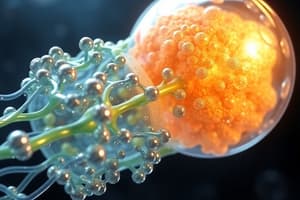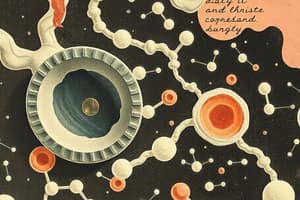Podcast
Questions and Answers
Which transport mechanism involves the movement of molecules and ions from higher to lower concentration?
Which transport mechanism involves the movement of molecules and ions from higher to lower concentration?
- Active transport
- Vesicle-mediated transport
- Facilitated diffusion (correct)
- Simple diffusion through protein channels
What type of transport requires the expenditure of metabolic energy and involves specific carrier proteins?
What type of transport requires the expenditure of metabolic energy and involves specific carrier proteins?
- Active transport (correct)
- Facilitated diffusion
- Vesicle-mediated transport
- Simple diffusion through lipid bilayer
Which type of transport utilizes ATPases that pump solutes across membranes by hydrolyzing ATP?
Which type of transport utilizes ATPases that pump solutes across membranes by hydrolyzing ATP?
- Vesicle-mediated transport
- Secondary active transport
- Primary active transport (correct)
- Facilitated diffusion
What factor particularly affects the rate of diffusion of ions across a membrane?
What factor particularly affects the rate of diffusion of ions across a membrane?
Which transport mechanism involves the transport of two solutes through the same transporter protein, one along its gradient and the other against its gradient?
Which transport mechanism involves the transport of two solutes through the same transporter protein, one along its gradient and the other against its gradient?
What type of transport requires the transport of a substance against its concentration gradient with the help of a specific carrier protein?
What type of transport requires the transport of a substance against its concentration gradient with the help of a specific carrier protein?
Flashcards are hidden until you start studying
Study Notes
Passive Transport
- Movement of molecules and ions from an area of higher concentration to an area of lower concentration.
- Does not require energy expenditure.
- Driven by the concentration gradient.
Active Transport
- Requires the expenditure of metabolic energy (ATP).
- Involves specific carrier proteins.
- Moves solutes against their concentration gradients.
Primary Active Transport
- Utilizes ATPases that pump solutes across membranes by hydrolyzing ATP.
- Examples include the sodium-potassium pump and the proton pump.
Diffusion
- The rate of diffusion is affected by several factors, including the concentration gradient, temperature, size of the molecules, and membrane permeability.
- The larger the concentration gradient, the faster the diffusion rate.
- Higher temperatures increase the rate of diffusion.
- Smaller molecules diffuse faster than larger molecules.
- Membranes with higher permeability allow for faster diffusion.
Secondary Active Transport
- Involves the transport of two solutes through the same transporter protein.
- One solute moves along its concentration gradient (downhill), providing energy for the movement of the other solute against its concentration gradient (uphill).
Facilitated Diffusion
- Requires the transport of a substance against its concentration gradient.
- Involves a specific carrier protein.
- Does not require ATP expenditure.
- Movement is driven by the concentration gradient.
Studying That Suits You
Use AI to generate personalized quizzes and flashcards to suit your learning preferences.




